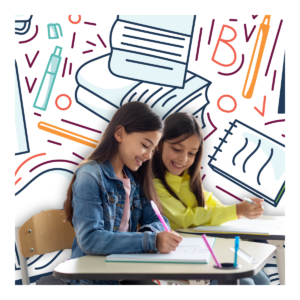 The relationship between reading and writing is undeniable, but often overlooked. What we read informs how we write, and the decisions we make when writing enable us to appreciate the work of other authors.
The relationship between reading and writing is undeniable, but often overlooked. What we read informs how we write, and the decisions we make when writing enable us to appreciate the work of other authors.
For students, understanding an author’s craft as the deliberate decisions an author makes to ensure their ideas are accessible, engage their readers, and set their work apart demystifies the writing process. Knowledge of craft provides the schema required for readers to make inferences and draw conclusions necessary for understanding, enjoying, and analyzing texts.
Reading is Creative Problem-Solving
Each reader comes to a text with a different set of experiences and expectations, and each reader leaves with a different set of memories and reactions. At the word level, learners decode with their eyes or fingers and do the work of determining which sounds, letters, and groups of letters are making in the context. At the phrase and sentence levels, readers, including listeners and viewers, make distinctions between explicit and implicit meanings and recognize when authors are using a word or phrase in a new or creative way. Each text presents a multitude of problems to be solved.
Readers create their own meaning based on the work of authors and illustrators. The purpose, knowledge, experiences, and even energy level and mood students bring to a text impact their understanding of the content and how it will affect them.
Students explore narratives looking for and finding familiar patterns or noticing when a story takes an unexpected turn. Based on the prior knowledge and emotions they bring to a tale, they may be creating lessons and themes not only different from what their peers take from the story, but even different from the intent of the author. As those of us who return to favorite novels year after year know, the same reader can have a vastly different experience with and take away significantly different lessons, connections, or next steps based on when we read a book. The author has laid the groundwork, but the visuals and lessons we take away are our own.
Though often dismissed as informational pieces seem to be more predictable ways to share “just the facts”, each reader is making their own meaning based on the details they determine are most important and the ways in which they connect to the information. Like a game of telephone played through the mind of one, each reader turns new information over, filters it, and creates something unique. When reading a new text on ecosystems, students may use completely different strategies to make sense of the information. While one student remembers a nature series on the topic and makes connections to what they already know, another will create analogies from a different subject area where they have more expertise to understand the new content, and another will step away from the text completely to search for clarification online or in other sources in the classroom. Each of these students is attacking the same material, but in different, creative ways.
Writing is Creative Problem Solving
Writing is, at its heart, a creative endeavor. Writing in school settings is often accompanied by additional guidelines or limits as students respond to prompts or are asked to write using specific structures. However, even in these situations, the writer has as much opportunity left for creativity as there is for the painter who must contain their vision within the limits of the canvas. Many aspiring authors take comfort in the structure or guidelines provided for them and feel paralyzed when asked to “free write.” School writing is an opportunity for creativity within constraints.
Writing is a process. Many authors have made similar points, but one that sticks with me is Ernest Hemingway’s claim that “The only kind of writing is rewriting.” When I meet adults who “hate writing,” it’s almost always because of how much they hated the writing process they were taught in school. Many experienced a strictly dictated approach devoid of creativity in which they joylessly mimicked the step-by-step writing described in the programs their teachers were expected to follow. For these potential authors, skillful writing was an opaque process hidden behind unclear or unknown criteria that seemed to be the sole purview of an elite class of professional authors. Seeing their best efforts met with the red pen marketing their every misstep and missing their points left them demoralized. I am convinced that what they hate is not writing, but drudgery. It doesn’t have to be like that.
Authors continually problem-solve. The constraints of writing assignments present numerous opportunities to flex their problem-solving muscles. To ensure their audience is able to understand and enjoy the work they create, authors remove extraneous information, experiment with dozens of words and phrases until they find the one that makes a sentence sing, or even scrap entire chapters or sections that pull focus from the theme or thesis as they refine a piece. Skill with craft comes from experimentation with language, structure, voice, and style as developing authors try things on for size.
I’ve found myself and the students I’ve had the pleasure to work with to be the most creative when we are at play. Along this line, experimentation with craft, while challenging like many games, can be fun. Just as many children enjoy playing dress up or pretending to be their favorite heroes, young writers enjoy stepping into the shoes of their favorite authors. In the fourth grade, I wrote a “long” story with incredible detail, nail-biting action sequences, and moving internal dialogue … that was a complete ripoff of Gary Paulsen’s beloved novel, Hatchet. At age nine, I wasn’t stealing from Mr. Paulsen, I was pretending to be him, and as time went on, other authors, while I found my own voice. Students find confidence doing the same and often respond to books like “Love that Dog” by Sharon Creech that encourage writing in many styles and voices. Just as playing house in pre-K develops the empathy, listening, and other skills necessary to be a good partner or parent later in life, creative writing activities help learners develop the foundational skills that will inform their own craft and voice.
What can we do?
First, we need to help students understand this connection and the role creativity plays in both. At its most basic, deliberate practice in reading will support their writing and vice versa. Going a bit deeper, each undertaking requires their creativity as they experiment, imagine, and revise their thinking, looking for ways to understand and be understood.
Second, we must engage students in the metacognitive cycle, supporting their understanding of themselves as both readers and writers. Analyzing the craft of other authors can help them realize possible strategies that they can apply to their own writing. The same is true when teachers or peers think aloud and model how they navigate texts and other media. Helping students recognize and reflect on the strategies that they are using and whether or not they are working as both readers and writers.
Finally, we must create opportunities for students to learn the strategies and practice the thinking and skills necessary to make connections between reading and writing are four high-impact, research-based instructional strategies that our TCC network knows you can implement immediately to strengthen students’ reading-writing connections and their performance in both:
 1. Interactive Read-Alouds
1. Interactive Read-Alouds
Interactive read-alouds actively involve students in discussions about authors’ choices, fostering critical thinking and deeper comprehension. All students need to have opportunities to hear quality texts read aloud well and discuss how these texts were written. Immediately following these discussions, students can revise their own writing or begin a new piece using what they have learned to demonstrate their understanding of the craft moves examined.
Classroom Example: While reading “The Other Side” by Jacqueline Woodson, pause to ask students to discuss the author’s decisions regarding point of view and character development, encouraging them to reflect on how these choices impact the story. What words and phrases helped you to understand each character and their relationship? How do you think the author made these choices? How would the text be different if they had chosen other words?
Research Tidbit: Beck and McKeown (2001) explored how interactive read-alouds deepen comprehension and support vocabulary acquisition, laying the groundwork for students to better understand and apply the author’s craft.
2. Mentor Text Analysis
Utilizing mentor texts provides concrete examples of effective writing. As students analyze these examples, they uncover specific craft elements authors employ, such as figurative language, pacing, and dialogue. This is an excellent opportunity for students to revise or rewrite a piece of their own or one from another author to use the voice and craft of the author they are studying. This helps them to recognize craft in what they read and provides practice in making difficult decisions as an author.
Classroom Example: After reading Patricia Polacco’s “Thank You, Mr. Falker,” students identify and discuss specific examples of powerful imagery and descriptive language. They then apply similar techniques in their own narratives.
Research Support: Gallagher (2011) underscores the effectiveness of mentor texts, emphasizing their role in modeling exemplary writing and deepening students’ analytical skills.
 3. Writing Workshops Focused on Revision
3. Writing Workshops Focused on Revision
Revision workshops teach students to view writing as a craft that evolves through reflection and revision, emphasizing the writing process rather than merely the final product. This mindset of revision can and should be extended to other areas in school. Illustrate a scene or draw a diagram? Revise to add details and clarify the most important information. Solve a complex problem? Review your process and strategies and look for ways to become more precise or efficient.
Classroom Example: Facilitate peer-review sessions where students give and receive constructive feedback specifically targeting craft elements like sentence fluency and voice.
Research Tidbit: Fletcher and Portalupi (2001) advocate for writing workshops, demonstrating how purposeful revision builds deeper understanding of craft and strengthens students’ overall writing abilities.
4. Craft Mini-Lessons
Brief, targeted mini-lessons explicitly teach elements of the author’s craft and provide immediate opportunities for students to practice applying these techniques. A significant percentage of comprehension standards demand analysis. Students must know the “moves” that authors make and be able to both recognize them in texts and replicate them in their own writing if they are expected to analyze what they read.
Classroom Example: After a mini-lesson on creating engaging hooks, students practice drafting compelling opening sentences for their narratives, sharing and refining their ideas in small groups.
Research Tidbit: Calkins (1994) emphasizes the value of mini-lessons in explicitly teaching craft, noting they significantly improve students’ ability to independently apply these skills.
Reading and writing each present their own sets of problems to be solved. Recognizing how the two subjects are connected and how each is made better by an understanding of craft enables the transfer of skills and understanding between work as authors and readers. The better a student understands the techniques that bring quality writing to life, the better they are at crafting their own writing and appreciating and responding to the writing of others. Harnessing the innate creativity of learners and encouraging them to experiment with how they decode, comprehend, and analyze text, as well as how they choose to organize, revise, and share their ideas, increases independence and retains the joy early learners find in literacy work. All of this is possible when students engage in activities like the ones listed above and have opportunities to reflect on what they are learning with the guidance of a dedicated educator like you.
References
Beck, I. L., & McKeown, M. G. (2001). Text Talk: Capturing the benefits of read-aloud experiences for young children. The Reading Teacher, 55(1), 10–20.
Calkins, L. (1994). The Art of Teaching Writing. Heinemann.
Fletcher, R., & Portalupi, J. (2001). Writing Workshop: The Essential Guide. Heinemann.
Gallagher, K. (2011). Write Like This: Teaching Real-World Writing Through Modeling and Mentor Texts. Stenhouse Publishers.



